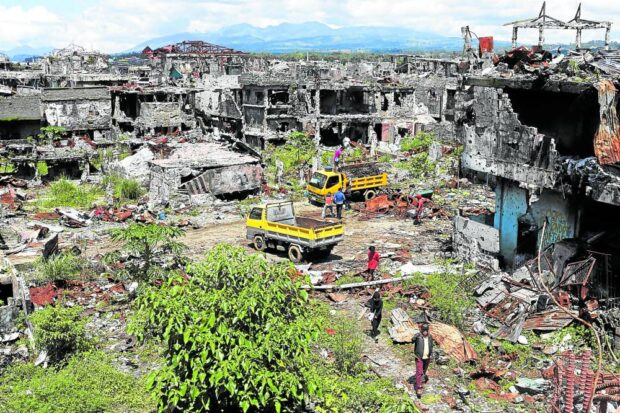P1 billion set aside for Marawi compensation gone in a day

BATTLE RUINS | In this May 2018 photo, Marawi residents are allowed access to the main battle area at the city center to inspect their properties and neighborhoods seven months after the fighting between government troops and Islamic State-linked militants ended. (File photo by JEOFFREY MAITEM / Inquirer Mindanao)
MANILA, Philippines — The head of the Marawi Compensation Board (MCB) on Monday informed a panel of the House of Representatives that the P1 billion set aside to compensate victims of the 2017 Marawi siege was nearly depleted on the very first day of processing claims.
MCB chairperson Maisara Latiph told the House ad hoc committee on Marawi rehabilitation and victims compensation that on July 4, when the board began accepting compensation applications, they received over P800 million in claims.
She noted that as of July 27, the MCB was processing 2,073 claims out of an expected 12,000 and said that the P1-billion fund for victims’ compensation was apparently insufficient.
“Our initial compensation fund is just P1 billion, so we are anticipating paying on or before December all those who have filed,” Latiph said, adding that the release of compensation could begin this month.
Heirs of the deceased or legally presumed dead in the Marawi siege are entitled to P350,000 in compensation.
Residents with destroyed properties may be provided with a P15,000 package and those with damaged personal properties, P12,000. A destroyed structure’s floor area may be allotted P18,000 per square meter.
‘How many millions?’
Latiph said the MCB was only directed, under Republic Act (RA) No. 11696 or the Marawi Siege Victims Compensation Act of 2022, to compensate for lives lost as well as personal and structural property damage.
“For one claimant alone, who is representing one of the big families, the compensation is P50 million. That’s for their property, one of the oldest schools in Marawi City, that got destroyed,” the MCB chief said.
She added: “These are millions and millions [of pesos] so imagine, how many of them would make claims. There were 32 private schools damaged. How many millions would that be? There were private clinics, hospitals, businesses. One of the businesses alone had an inventory of P20 million [worth of] goods.”
Operating budget
She noted that there were at least 12,500 structures destroyed and 77,000 residents expected to make compensatory claims.
RA 11696 covers residents in 26 barangays deemed to be the most affected areas in the Marawi siege as well as eight other affected areas.
Latiph had sought an additional operating budget, saying that, “We don’t want anyone to be left behind. We only have a year and just started this month and we were overwhelmed by the number of claimants. Our office’s capacity doesn’t match the number of people so we have to limit claimants to 200 a day.”
“If we could increase [our capacity] to 400 a day, we could accommodate more people. But our budget is very limited,” she added.
“Operational budget has to match the demand on the ground because the demand on the ground is higher than the budget that was given us,” she pointed out further.
She also said the MCB secretariat needs its own staff, adding that the board should not send out their staff to do field work such as investigation of claims.
Lanao del Sur Rep. Zia Adiong, the ad hoc committee chairperson, assured the MCB that the panel would push for more funding for the Marawi siege victims.
On May 23, 2017, Maute and Abu Sayyaf groups, backed by several foreign fighters, rampaged across Marawi and seized large parts of the city to establish an Islamic State (IS) enclave in Southeast Asia.
The siege lasted for five months until then President Rodrigo Duterte declared Marawi “liberated from terrorist influence” on Oct. 17, 2017, after the military confirmed the deaths of Isnilon Hapilon, a leader of the Abu Sayyaf and IS in Southeast Asia, and Omarkhayam Maute of Lanao del Sur’s Maute group.
The Marawi siege marked the Philippines’ biggest internal security crisis in years. It also led to widespread destruction of property and infrastructure and loss of lives in the Islamic city, with more than 1,000 people killed in the fighting, including more than 800 terrorists.
More than 1,700 soldiers were wounded in combat and more than 350,000 people were forced to flee their homes and live in temporary shelters.
Based on a 2017 assessment, the damage was placed at P11.5 billion and losses at P7 billion in the 24 villages comprising the most affected areas.
But the assessment glossed over the looting of personal properties as it mainly focused on damaged public and private structures.
According to then-Finance Secretary Carlos Dominguez III, the overall financing requirement for Marawi would amount to P72.58 billion over a five-year period up to 2022.
Felino Palafox Jr., an architect and urban planner who is committed to helping in the reconstruction of Marawi, previously estimated that it might take “70 years” to bring Marawi back to what it was before the conflict.